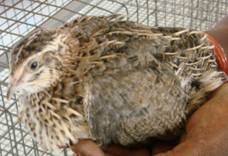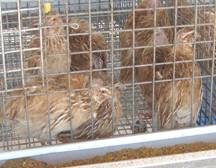 |
|||||||||||||||||||||||||||||||||||||||||||||
| Major Activities |
Poultry :: Breeds :: Care & Management |
||||||||||||||||||||||||||||||||||||||||||||
Artificial Insemination |
|||||||||||||||||||||||||||||||||||||||||||||
CARE AND MANAGEMENTHealth careJapanese quails are hardier. They seldom have disease problems. Therefore, there is no need for routine immunization programme as with other poultry species. One major disease that affects Japanese quail is quail enteritis. This disease can be treated using appropriate antibiotics under Veterinarian’s advice. Care of Adult Quails The males and females can be separated based on physical appearance at about
Quails reach sexual maturity at about six weeks of age and weigh 120 g. Adults require 150-180 cm 2 per quail in laying cage. A feeder space of 2-3 cm per quail and water space of 2 cm has to be provided. For laying flock a photoperiod of 16 hours is desirable for good egg production. Layer quails may be provided with a mash containing 22% protein and 2650 K cal/kg of ME. Japanese quails reproduce well in all seasons. The eggs are laid from evening, the peak being between 6.30 – 7.30 p.m. The eggs laid during second year of lay are very much fewer than first year. Quail egg weighs around 10 g and is characterised by a variety of colour pattern ranging from dark brown, blue and white to buff each mottled with black, brown and blue. The egg shell is very thin and therefore breaks easily. Care of quail chicks
( Source: KVK, Namakkal ) Care of Breeding QuailsGood fertility can be obtained with a male-female ratio of 1:2. After introduction of male to a female flock, fertile eggs can be collected from 4th day onwards. Optimum fertility is obtained when the age of breeding flock is 8 months or less. Hatchability of fertile eggs rapidly declines when eggs are collected from older females. However, this effect is not observed with males. Feed ration for Japanese Quails
(Source: Kerala Agricultural University) Care of hatching eggsShell of quail eggs are comparatively thinner and therefore should be handled carefully. Eggs should be held in an atmosphere free of dust and having a temperature of 14 to 16 0 C with a relative humidity of 70 to 80%. Eggs held even under these conditions should be used for hatching within 7 days of holding. The incubation period of quail egg is 18 days. Quail eggs can be incubated artificially using forced draft incubator at a temperature of 36.9 – 37.2 0 C with a relative humidity of 60 to 70%. Eggs should be turned 4 to 6 times daily upto 14 days of incubation.
Quail Quail Egg ( Source: KVK, Namakkal ) |
|||||||||||||||||||||||||||||||||||||||||||||
Technologies |
|||||||||||||||||||||||||||||||||||||||||||||
Milking Machine |
|||||||||||||||||||||||||||||||||||||||||||||
Veterinary Services |
|||||||||||||||||||||||||||||||||||||||||||||
Hospitals in TN |
|||||||||||||||||||||||||||||||||||||||||||||
| Home | Success Stories | Publication | Gallery | Forms | FAQs | Related Links | Contact | |
|||||||||||||||||||||||||||||||||||||||||||||
| © All Rights Reserved. TNAU-2008. |
|||||||||||||||||||||||||||||||||||||||||||||



